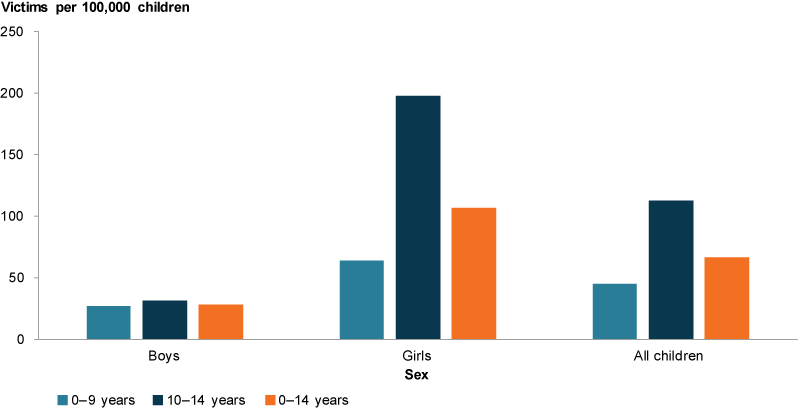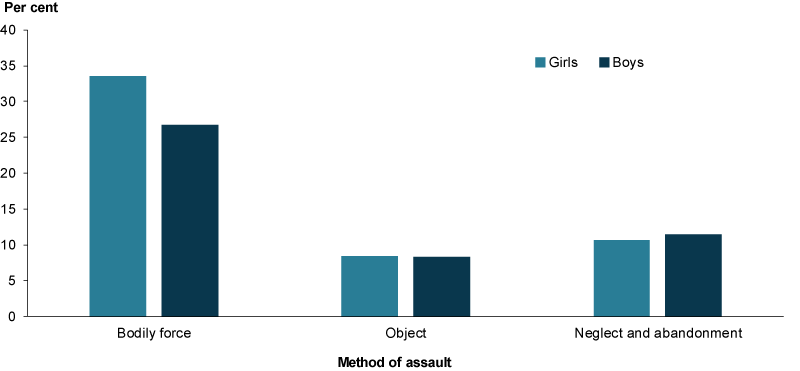Sabourinã¢â‚¬â„¢s Important Research on Family Violence Found Which of the Following to Be True?
Data updates
25/02/22 – In the Data section, updated data related to children exposed to family violence are presented in Data tables: Australia's children 2022 – Justice and prophylactic. The spider web report text was final updated in December 2019.
Key findings
- The 2016 Personal Rubber Survey (PSS) estimates that about i in 6 women (sixteen% or 1.5 million) and 1 in nine men (11% or 992,000) experienced concrete and/or sexual corruption before the age of 15.
- Co-ordinate to the 2018 ABS Recorded Criminal offence information, more than than ii-fifths of all sexual assaults recorded against children anile 0–14 (effectually 3,100) were perpetrated by a family unit member.
- Sexual assaults perpetrated by family members were most four times more than likely perpetrated against girls than boys (107.0 sexual assaults per 100,000 girls compared with 28.3 sexual assaults per 100,000 boys).
- Where the perpetrator was specified, a parent or another family fellow member was the perpetrator in more than half (58%) of assault-related hospitalisations involving children aged 0–14 in 2016–17.
Violence comes in many forms, including:
- family unit or domestic violence
- sexual and other physical assault
- maltreatment
- bullying
- emotional or psychological abuse (WHO 2016).
A kid can exist exposed to violence either past:
- directly experiencing the violence (being the target)
- witnessing violence beingness inflicted upon somebody else (Kulkarni et al. 2011).
When a child is exposed to violence within their family this is considered family unit violence (AIHW 2019) (Box one). When children themselves directly experience family violence, the perpetrator is generally the child's parent/guardian or in a relationship with the child's parent/guardian, or more broadly speaking a person in a position of trust (AIHW 2018; Campo 2015).
Box one: Defining family, domestic and sexual violence
Family violence refers to whatever violence betwixt family unit members, typically where the perpetrator exercises power and control over another person. This violence tin be sexual or non-sexual. Family unit violence is the preferred term for violence between Indigenous people, as it covers the extended family and kinship relationships in which violence may occur (COAG 2011).
Domestic violence is considered a subset of family violence. It refers to violent behaviour between current or previous intimate partners (AIHW 2019). Sexual violence refers to behaviours of a sexual nature carried out against a person's will. It tin can exist perpetrated past a current or previous partner, other known people, or strangers.
Being exposed to family violence can take a wide range of detrimental impacts on a child'due south development, mental and physical health, housing situation and general wellbeing (AIHW 2019; ANROWS 2018; WHO 2016). More than specifically, research has institute exposure to family unit violence is associated with a range of outcomes, including:
- diminished educational attainment
- reduced social participation in early machismo
- concrete and psychological disorders
- suicidal ideation
- behavioural difficulties
- homelessness
- time to come victimisation and/or violent offending (AIHW 2018; Bland & Shallcross 2015; Campo 2015; De Maio et al. 2013; Holt et al. 2008; Jaffe et al. 2012; Knight 2015).
The impacts of childhood exposure to family violence volition exist explored as part of the Commencement national study of child abuse and neglect in Australia, beingness conducted from 2019–2023 (QUT 2019).
When a kid is exposed to family violence along with multiple hazard factors, such as socioeconomic disadvantage, parental mental ill health, and parental substance corruption, more farthermost negative outcomes are probable (Casey et al. 2009; Campo 2015; Fergusson et al. 2006; Fulu et al. 2013).
However, exposure to family violence lonely does non mean a child volition necessarily experience negative outcomes. With the correct support, children exposed to family unit violence may take increased resilience after in life (Alaggia & Donohue 2018; Campo 2015; Jaffe et al. 2012).
For this section, children who take straight experienced family violence are identified through 2018 Recorded Law-breaking—Victims information and the AIHW National Hospital Morbidity Database, where data on the relationship of the perpetrator to the victim are bachelor (Box 1 in Children and crime). These information are a subset of the relevant assault data discussed in Children and crime. Some information from the 2016 ABS PSS on children who witness violence in their dwelling, and adults who experienced family violence as a kid, are as well included (Box 2).
Often children exposed to family violence may accept contact with state and territory child protection systems (see, Child abuse and neglect and Children in non-parental care). While this section focuses on children who take experienced family violence, there are other instances where a child experiences violence, including those described in Children and crime and Bullying.
Box 2: ABS Personal Safety Survey
The ABS 2016 PSS provides national data on the prevalence of violence experienced by women and men. Violence refers to any incident involving the occurrence, try or threat of either physical or sexual assault. Where a person has experienced more than i type of violence, their experiences are counted separately for each type.
The PSS collected in-depth information from fifteen,589 women and five,653 men (21,242 persons in total) aged 18 and over about:
- any violence experienced since the age of 15
- any violence experienced in the 12 months before the survey
- electric current and previous partner violence and emotional abuse since the age of xv
- stalking since the historic period of fifteen
- concrete and sexual abuse before the age of 15
- witnessing violence betwixt a parent and partner before the historic period of 15
- lifetime feel of sexual harassment
- general feelings of safe (ABS 2017).
Children exposed to family violence
The 2016 PSS estimates that about 1 in 6 women (16% or 1.5 million) and 1 in 9 men (xi% or 992,000) experienced physical and/or sexual abuse earlier the age of 15.
Parents were the most common perpetrators of physical abuse before this age. Effectually 45% of adults experienced physical abuse before the age of 15 by a father or stepfather, and 24% by a mother or stepmother. Where mothers or stepmothers were identified as the perpetrator, victims were more likely their daughters (66%) than their sons (35%) (ABS 2018a).
Of those adults who experienced sexual corruption before the age of 15, nearly 8 in 10 (79%) were abused by a relative, friend, associate or neighbor. A minority were abused past a stranger (xi%) (ABS 2018a).
The 2016 PSS besides estimated that of those who had experienced violence from a previous partner and had children in their care when the violence occurred, 418,000 women (68%) and 92,200 men (lx%) reported that the children had seen or heard the violence.
Police responses
Sexual attack
According to ABS Recorded Criminal offense data, in 2018 effectually 3,100 sexual assaults against children aged 0–14 were perpetrated by a family member (see Children and offense). This represented more than two-fifths of all sexual assaults recorded confronting children aged 0–14.
Sexual assaults perpetrated past family members were:
- more probable perpetrated against girls than boys, with a rate of 107.0 sexual assaults per 100,000 girls aged 0–14, compared with 28.3 sexual assaults per 100,000 for boys aged 0–14 (Effigy 1)
- highest for girls aged x–14, with a charge per unit of 197.eight sexual assaults per 100,000.
Rates showed no real variation betwixt 2014 and 2018. This was true for all age and sex activity groups.
Figure 1: Victims of sexual assault past a family unit fellow member, past age, 2018

Chart: AIHW. Source: ABS 2019.
Other assault
For the 6 states and territories that had assault data available, effectually 3,900 assaults against children aged 0–14 in 2018 were considered family violence. More than than half of these (55%) were for children aged x–14. Except for Tasmania, rates of assault for children aged 10–fourteen were double or more than the rates of children aged 0–9 for all states and territories.
The rate of other assaults perpetrated past a family member against children was college in the Northern Territory than in other states and territories (237.3 assaults per 100,000 children anile 0–14) (Effigy 2). Western Australian and Northern Territory had the highest charge per unit of assault perpetrated past a family member against children aged x–14 years (327.two assaults per 100,000 children anile 10–14 and 436.8 assaults per 100,000 children, respectively).
Effigy ii: Victims of assault by a family unit member, by jurisdiction and historic period, 2018
Nautical chart: AIHW. Source: ABS 2019.
Hospitalised cases due to family violence cases
In 2016–17, there were more than 600 hospitalised assault cases of children aged 0–14, including 156 Indigenous children.
For cases where the perpetrator was specified (79%, or 481), nearly:
- 1 in 2 (45%, or 217) children were assaulted past a parent
- 1 in 8 (13%, or 71) by another family member.
For Indigenous children, about ii in 3 (68%, or 83) assaults were perpetrated past a parent or family unit member.
Of the 131 hospitalised attack cases of girls due to family unit violence:
- 44 (34%) involved assault by actual force
- 11 (8%) with an object
- 14 (xi%) neglect and abandonment by family.
Of the 157 hospitalised assail cases of boys due to family unit violence:
- 42 (27%) involved assault by bodily force
- 13 (eight%) with an object
- 18 (11%) fail and abandonment by family (Effigy 3).
Figure three: Hospitalised attack cases by a family fellow member, children aged 0–14, by type of assault, past sex, 2016–17

Nautical chart: AIHW. Source: AIHW National Hospital Morbidity Database.
Data limitations and development opportunities
Information technology is difficult to obtain consummate and robust data on children's exposure to family violence due to the sensitivity of the subject field, with administrative sources only able to place reported cases and nigh large-scale population surveys focusing on adult experiences and/or their perceived knowledge of child experiences.
While administrative data collections, such as police and hospital data, can provide some insights, these information sources are likely to underestimate the true extent of children exposed to family unit violence, with many children (and not-perpetrating parent/guardians) reluctant to report family unit violence to the law or seek necessary medical attention (ABS 2011; Stoltenborgh et al. 2011, 2013).
To heighten current administrative data on family violence, the identification and drove of information on family violence in other routinely collected administrative data sources is important. Improvements to existing collections, for example child protection, specialist homelessness services, and perinatal, are underway (AIHW 2019).
To supplement administrative data, the Commencement national written report of kid abuse and neglect in Australia, being conducted from 2019–2023, may provide additional insight into family violence by retrospectively reporting on childhood experiences of family violence for respondents aged xvi and over (QUT 2019). In improver to collecting data on childhood experiences retrospectively, information nerveless directly from children is likewise important (see 'What's missing' in Justice and rubber).
Where practice I find more data ?
For more than information on:
- children'due south exposure to family violence, run into: Domestic violence in the National Framework for Protecting Australia's Children
- family, domestic and sexual violence, run into: Family, domestic and sexual violence in Australia: continuing the national story 2019.
Source: https://www.aihw.gov.au/reports/children-youth/australias-children/contents/justice-and-safety/children-exposed-to-family-violence
0 Response to "Sabourinã¢â‚¬â„¢s Important Research on Family Violence Found Which of the Following to Be True?"
Postar um comentário